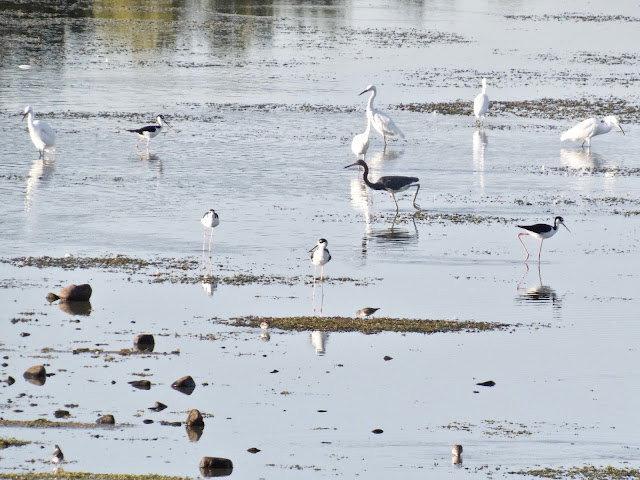 |
| Recharge Pond at Glendale |
Birds on these ponds are great fun to observe.
 |
| TRICOLORED HERON (right); Great Egrets (left) |
The TRI-COLORED HERON has been visiting the ponds off and on and it was present today even though that was not the bird I drove west to see. But there it was -- fairly close to shore - hanging out with the egrets. Note the above wing posture on the GREAT EGRETs. Sometimes that's done to produce "shade" so the bird can quickly stab its prey without being detected. Sometimes it's done as a non-aggressive marking of its feeding territory. Since the TRI-COLORED HERON is present, it may have felt it necessary to say, "This area is mine."
 |
| TRICOLORED HERON (foreground); Black-necked Stilts (background) |
 |
| WILSON'S PHALAROPE (a delightful bird that swims in circles to stir up food; sometimes a flock will be spinning simultaneously) |
 |
| GREEN HERON |
If you follow my blog, you know that I went all the way to Cape May, NJ, to see this species in early May when the RED KNOT was migrating north from the tip of South America to its Arctic breeding grounds. It stops off there to fill up on horseshoe crab eggs. Whether or not this is the same subspecies (rufa) or not, I really don't know. It would not be on its migratory route back south.
So, I'll post photos of the RED KNOT at Glendale and then a few from Cape May, NJ, to show the different plumages but the same essential bird size and shape.
 |
| RED KNOT- Glendale - basic plumage |
 |
| RED KNOT - Cape May NJ - breeding plumage |
 |
| RED KNOT - Glendale - basic plumage (with Least Sandpipers) |
 |
Looking at the same bird, its differences and similarities are fascinating to observe.
Although I arrived at dawn and lasted for 2.5 hours at the wide open (no shade) ponds, I managed to sort through many sandpipers to pick out some more specialities before the heat told me to get back to the car. Again, two rare shorebirds in our Arizona desert!
* * *
View this checklist online at http://ebird.org/ebird/view/checklist/S38799515




That was an amazing discovery! I couldn't believe it. Those ponds are golden right now.....and not just with pee!
ReplyDeleteHa Ha! Yes, I can't believe the birds that have been showing ... including terns such as Caspian and today, I believe, it was the more likely Forster's. Great fun to see birds beyond our usual winter/summer residents.
ReplyDelete